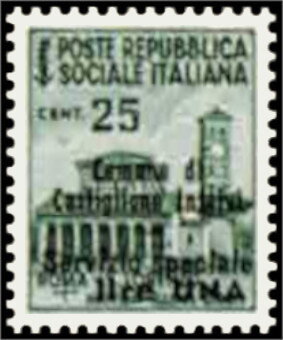Stamp: Basilica of San Lorenzo, Rome - Surcharged (Italy, Social Republic 1945)
Basilica of San Lorenzo, Rome - Surcharged (Italy, Social Republic 1945)
01 January (Italy, Social Republic ) within release Local Issue - Castiglione D'Intelvi goes into circulation Stamp Basilica of San Lorenzo, Rome - Surcharged face value 1 Italian lira
| Stamp Basilica of San Lorenzo, Rome - Surcharged in catalogues | |
|---|---|
| Michel: | Mi: IT L-CI 7 |
| Unificato: | Un: IT EL-CI 7 |
| Sassone: | Sas: IT EL-CI 7 |
Stamp is vertical format.
Surcharge: 1 Lira on 25 c. Overprint: Cimune di Casriglione Intelvi/Servizio specialeAlso in the issue Local Issue - Castiglione D'Intelvi:
- Stamp - Abbey of Monte Cassino - Surcharged face value 50;
- Stamp - Abbey of Monte Cassino - Surcharged face value 1;
- Stamp - Basilica of San Lorenzo, Rome - Surcharged face value 1;
- Stamp - Basilica of San Lorenzo, Rome - Surcharged face value 1;
- Stamp - Church if San Ciriaco, Ancona - Surcharged face value 50;
- Stamp - Drummer - Surcharged face value 1;
- Stamp - Drummer - Surcharged face value 1;
- Stamp - Drummer - Surcharged face value 1;
- Stamp - Julius Caesar (100-44 B.C. with fasces - Surcharged face value 1;
- Stamp - Loggia of the Merchants in Bologna - Surcharged face value 50;
- Stamp - Loggia of the Merchants in Bologna - Surcharged face value 1;
- Stamp - Loggia of the Merchants in Bologna - Surcharged face value 1;
- Stamp - Republican Fascist Italy - Surcharged face value 1;
Stamp Basilica of San Lorenzo, Rome - Surcharged it reflects the thematic directions:
A building or edifice is a structure with a roof and walls standing more or less permanently in one place, such as a house or factory. Buildings come in a variety of sizes, shapes and functions, and have been adapted throughout history for a wide number of factors, from building materials available, to weather conditions, to land prices, ground conditions, specific uses and aesthetic reasons. Buildings serve several needs of society – primarily as shelter from weather, security, living space, privacy, to store belongings, and to comfortably live and work. A building as a shelter represents a physical division of the human habitat (a place of comfort and safety) and the outside (a place that at times may be harsh and harmful).
A church building, often simply called a church, is a building used for Christian religious activities, particularly worship services. The term in its architectural sense is most often used by Christians to refer to their religious buildings, but it is sometimes used (by analogy) for buildings of other religions. In traditional Christian architecture, the church is often arranged in the shape of a Christian cross. When viewed from plan view the longest part of a cross is represented by the aisle and the junction of the cross is located at the altar area. Towers or domes are often added with the intention of directing the eye of the viewer towards the heavens and inspiring church visitors. Modern church buildings have a variety of architectural styles and layouts; many buildings that were designed for other purposes have now been converted for church use; and, similarly, many original church buildings have been put to other uses. The earliest identified Christian church was a house church founded between 233 and 256. During the 11th through 14th centuries, a wave of building of cathedrals and smaller parish churches occurred across Western Europe. A cathedral is a church, usually Roman Catholic, Anglican, Oriental Orthodox or Eastern Orthodox, housing the seat of a bishop.
A monument is a type of structure that was explicitly created to commemorate a person or event, or which has become relevant to a social group as a part of their remembrance of historic times or cultural heritage, due to its artistic, historical, political, technical or architectural importance. Examples of monuments include statues, (war) memorials, historical buildings, archaeological sites, and cultural assets. If there is a public interest in its preservation, a monument can for example be listed as a UNESCO World Heritage Site. The Palgrave Encyclopedia of Cultural Heritage and Conflict gives the next definition of monument:



